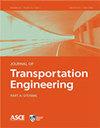Evaluation of Freeway Demand in Florida during the COVID-19 Pandemic from a Spatiotemporal Perspective
IF 1.8
4区 工程技术
Q3 ENGINEERING, CIVIL
Journal of Transportation Engineering Part A-Systems
Pub Date : 2023-08-01
DOI:10.1061/jtepbs.teeng-7177
引用次数: 0
Abstract
This study contributes to our understanding of the changes in traffic volumes on major roadway facilities in Florida due to COVID-19 pandemic from a spatiotemporal perspective. Three different models were tested in this studya) Linear regression model, b) Spatial Autoregressive Model (SAR) and c) Spatial Error Model (SEM). For the model estimation, traffic volume data for the year 2019 and 2020 from 3,957 detectors were augmented with independent variables, such asCOVID-19 case information, socioeconomics, land-use and built environment characteristics, roadway characteristics, meteorological information, and spatial locations. Traffic volume data was analyzed separately for weekdays and holidays. SEM models offered good fit and intuitive parameter estimates. The significant value of spatial autocorrelation coefficients in the SEM models support our hypothesis that common unobserved factors affect traffic volumes in neighboring detectors. The model results clearly indicate a disruption in normal traffic demand due to the increased transmission rate of COVID-19. The traffic demand for recreational areas, especially on the holidays, was found to have declined after March 2020. In addition, change in daily COVID-19 cases was found to have larger impact on South Florida (District 6)’s freeway demand on weekdays compared to other parts of the state. Further, the gradual increase of demand due to the rapid vaccination was also demonstrated in this study. The model system will help transportation researchers and policy makers understand the changes in freeway volume during the COVID-19 period as well as its spatiotemporal recovery.基于时空视角的2019冠状病毒病疫情期间佛罗里达州高速公路需求评估
本研究有助于我们从时空角度了解2019冠状病毒病大流行对佛罗里达州主要道路设施交通量的影响。本文采用线性回归模型(Linear regression model)、空间自回归模型(Spatial Autoregressive model, SAR)和空间误差模型(Spatial Error model, SEM)三种模型进行检验。在模型估计中,来自3957个检测器的2019年和2020年的交通量数据被添加了自变量,如covid -19病例信息、社会经济学、土地利用和建筑环境特征、道路特征、气象信息和空间位置。交通流量数据是在工作日和节假日分开分析的。SEM模型提供了良好的拟合和直观的参数估计。SEM模型中空间自相关系数的显著值支持了我们的假设,即常见的未观察到的因素会影响相邻检测器的交通量。模型结果清楚地表明,由于COVID-19传播率的增加,正常的交通需求受到干扰。2020年3月以后,休闲场所的交通需求,特别是节假日的交通需求有所下降。此外,与该州其他地区相比,每日新冠肺炎病例的变化对南佛罗里达州(第6区)工作日高速公路需求的影响更大。此外,本研究还证明了由于快速接种疫苗而逐渐增加的需求。该模型系统将帮助交通研究人员和政策制定者了解新冠肺炎期间高速公路交通量的变化及其时空恢复。
本文章由计算机程序翻译,如有差异,请以英文原文为准。
求助全文
约1分钟内获得全文
求助全文
来源期刊

Journal of Transportation Engineering Part A-Systems
Social Sciences-Transportation
CiteScore
3.80
自引率
14.30%
发文量
152
期刊介绍:
The Journal of Transportation Engineering will be renamed the Journal of Transportation Engineering, Part A: Systems. This change will take effect with the January 2017 issue. The editorial board remains the same and papers in review will continue through the process without delay. A new journal has been launched, Journal of Transportation Engineering, Part B: Pavements. The first issue will appear in 2017.
 求助内容:
求助内容: 应助结果提醒方式:
应助结果提醒方式:


